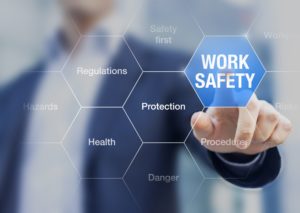Eyes are especially vulnerable to workplace injury and accidents, are such occurrences are typically easily avoided, but not always. Consider the fairly new phenomenon of laser pens. There are now many cases of pilots, civilian and military, who have suffered serious eye damage due to lasers being shone deliberately from the ground at aircraft. According to the Ministry of Defence, on average there is one reported case of a military plane or helicopter pilot being dazzled each week, while engaging in routine sorties. And in 2016, the Civil Aviation Authority (CAA) received reports of 1,258 laser incidents, with Heathrow being most frequently hit. It is not just aircraft; 578 such incidents have occurred on British railways since 2011, according to the British Transport Police . Such intentionally dangerous attacks can render pilots and drivers temporarily blind, and can cause permanent damage, depending on the power of the laser and the duration of exposure, and of course, pose a significant danger to those on board. Ultimately eye injuries can lead to victims becoming permanently blind.
who have suffered serious eye damage due to lasers being shone deliberately from the ground at aircraft. According to the Ministry of Defence, on average there is one reported case of a military plane or helicopter pilot being dazzled each week, while engaging in routine sorties. And in 2016, the Civil Aviation Authority (CAA) received reports of 1,258 laser incidents, with Heathrow being most frequently hit. It is not just aircraft; 578 such incidents have occurred on British railways since 2011, according to the British Transport Police . Such intentionally dangerous attacks can render pilots and drivers temporarily blind, and can cause permanent damage, depending on the power of the laser and the duration of exposure, and of course, pose a significant danger to those on board. Ultimately eye injuries can lead to victims becoming permanently blind.
Common causes of eye damage
Such is the fragility of the human eye, severe damage can happen during what may initially appear to be a minor occurrence; perhaps a flash of light, or a tiny spark or foreign object coming into contact with the surface of the eye. Eye injuries commonly occur due to flying debris (e.g. glass, wood, or metal), exposure to extreme light or heat, radiation, accidents involving tools or machines, natural objects such as branches, and chemicals. There is also a long-term risk of damage to eyes due to computers. Given the many thousands of hours workers spend in front of computer displays, if a monitor is not setup correctly, or working as it should, then long-term damage to the eyes can eventuate.
Types of damage to the eye
The range of potential eye injuries can make even those with strong stomachs rather squeamish. Some of the more common eye injuries which can occur may include:
- Corneal abrasions – the cornea is the outermost layer of the eye and can easily be scratched. Such injuries are often ignored and can heal quickly, but traumatic corneal abrasions, or foreign body abrasions can lead to more serious damage. If an object is lodged in the eye, it is important to seek immediate medical intervention, as tearing of the cornea (i.e. a rupture in the skin) can have more long-term consequences.
- Traumatic iritis – traumatic iritis is caused by a blunt object impacting the eye, causing the iris (the coloured part of the eye) to become inflamed.
- Hyphemas – In the event of being hit by a large force to the eye, bleeding can occur within the eye (hyphema)
- Orbital fractures – In extreme cases, the facial bones around the eye can be fractured.
- Chemical eye burns – High pH chemicals (i.e. alkali) burns can cause significant damage, not just to the external surface, but to the inner parts. Products such as ammonia, oven cleaners, and fertilisers can, in high doses, cause conditions like cataracts and glaucoma and may cause vision loss or blindness
- Other symptoms – pain, reddening, tearing, a sensation of sand in the eye, sensitivity to light, and an inability to look at light sources (also known as photophobia), are all potential symptoms of welders ‘arc eye’, caused by ineffective or defective protective welding equipment.
Preventing eye injuries in the workplace
All employers have a legal duty to ensure staff are safe from injury while at work. Prevention of most risks to the eyes can be achieved by using goggles, face shields, and visors (tinted, reinforced, or otherwise) which are designed for the specific task being undertaken. For example, welding goggles or masks are specially designed to filter out the harmful broad-spectrum radiation given off by welding arcs (the sparks that occur when welding). Other resolutions to eye damage risks include implementing guards on machines to prevent foreign objects and debris from flying up and hitting workers.
Display screen equipment users must undergo regular risk assessments to ensure screens are set up optimally, clear, fit for purpose, and free from glare. In addition, any computer user can request that their employer pays for them to have an eye check to determine if glasses are necessary.
Employers also need to ensure workers are told about any risks to their eyes, and how this can be minimised. It is essential clear signage is put in place where necessary to warn of any specific risks to the eyes of workers.
If you have any reason to believe you and your fellow work colleagues are being exposed to an uncontrolled risk which could cause eye damage, alert your manager, who will be able to ensure corrective action is put in place.
Can I claim if I have suffered an eye injury at work?
The answer to this question depends on the extent to which your employer failed to ensure your eye safety, and this directly led to your injury. Perhaps they have not implemented suitable protective goggles, or have introduced a new chemical into your work process which has the potential to cause eye burns if not handled correctly, and you were not informed of this risk. If you contact Russell Worth, we will take the time to review what has happened to you and quickly advise if you might have cause for a financial compensation claim. If you have been forced to take time off work, or if you are unsure if you will ever be able to return to your occupation, compensation will be vital to enable you to pay your bills and any other costs related to your accident, while covering any pain, and suffering you have endured.
At Russell Worth Solicitors we specialise in personal injury claims. If you have suffered a workplace injury and would like a free claim assessment, please call us now on 0800 028 2060 or complete our Online Claim Assessment.

